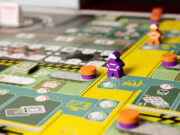 Perhaps for the same reasons I was initially drawn to play Scythe, I couldn’t help but pause when I saw the artwork for Tales from the Loop. A winter landscape with towering objects in the distance speaks to that ancient drive for exploration we inherently all have, a desire to know and understand what lies beyond. A monolithic, glowing pillar looks alien, and yet I’m intrigued. It’s this compelling setting that has created so many avenues to explore this world. Tales from the Loop – the board game from Free League adds one more avenue into that place. Combing cooperative gameplay with elements of RPGs, Tales from the Loop hopes to offer players a taste of this world.
Perhaps for the same reasons I was initially drawn to play Scythe, I couldn’t help but pause when I saw the artwork for Tales from the Loop. A winter landscape with towering objects in the distance speaks to that ancient drive for exploration we inherently all have, a desire to know and understand what lies beyond. A monolithic, glowing pillar looks alien, and yet I’m intrigued. It’s this compelling setting that has created so many avenues to explore this world. Tales from the Loop – the board game from Free League adds one more avenue into that place. Combing cooperative gameplay with elements of RPGs, Tales from the Loop hopes to offer players a taste of this world.
Gameplay Overview:
In Tales from the Loop, players are latchkey kids in an alternative 1980s Sweden, uncovering mysteries about their town, all while trying to maintain a somewhat normal life. Oh, and there are various machines, possibly a dinosaur, and a looming powerplant you can hear humming if you put your ear to the ground. There are many ways to experience Tales from the Loop, which change up the difficulty or offer a sandbox experience. However, this review will focus on the standard mode.

Tales from the Loop is a scenario-based co-op. There are seven scenarios in the base game, and a couple of expansions are also available separately. Each scenario sets the scene for your story. As a team, you’ll work to uncover the mystery embedded in your scenario through Diary Cards. These help move the story along, eventually revealing the win/loss condition, as this won’t be known at the start. You will also need to track all the Rumors flying around, which provide investigative breadcrumbs for you to follow. Successfully addressing them can yield items or other perks but failing has negative consequences too.
Deciding whether a Rumor has been addressed or not is done through a dice roll, where rolling a 6 is a success. Improving your chances by using strengths and getting help from others or items increases the number of dice available to make this success. These types of rolls will also decide whether a player can hack a robot that’s roaming around or avoid it if it’s on the prowl. As if all this wasn’t enough, each player will also need to complete a chore assigned to them by the end of the game. In short, Tales from the Loop has a lot going on.

Each scenario will play out in six or twelve rounds. Each round is broken down into three phases: a school phase, an adventure phase, and an end phase. During the school phase, players assess the Diary cards in play. These give direction for a round and things to be cautious of. Everyone replenishes their Time Cubes, which dictate how many actions a player can take that round. The First Player draws a School card; this indicates how many new Rumors will be revealed this round and what mandatory test they will need to complete, either on their own or with the help of their friends. New Rumors are revealed; if the row holding these is full, push out any cards and increase the negative game condition. Last, any machines in play will move about the board.
The adventure phase is where the bulk of the actions for players take place. Here, they can move around the board, check out and address Rumors, trade items, and try to hack machines. Every action cost players at least one of the six Time Cubes they start with. These can get tied up in negative effects, like being grounded or injured. This limits what they can do that round, but there are ways to get these back. Lastly, the end phase, which is mainly cleanup, where players discard down to the item limit of four, see whether they made it home for dinner, and modify their Favor (which impacts actions they can take or can get them grounded), healing, checking chores and Diary cards. Certainly, this doesn’t cover every aspect of the game, but hopefully gives an overall sense of the flow.

Game Experience:
Well, what do you want first, the good news or the bad news? Let’s start on a good note. Tales from the Loop has a very compelling art style and graphic design. Before Tales was an RPG, board game, or Amazon TV show, it was a narrative art book from the author and artist Simon Stålenhag. It’s kind of amazing to think about all that has come from this created world. The RPG was my first contact with this broader space, although I never had the opportunity to explore it with any sort of campaign. But coupling this strange new/old world with the pull of 80s nostalgia is hard for many to resist. Like any good art, you want to stop and appreciate it. Thankfully, you’ll have that opportunity, as various portrayed scenes from the book make their way into the board game. As if the art wasn’t interesting enough, the graphic design for the game is also intriguing, with a clean aesthetic that might make one think “Ikea” and “Ian O’Toole.” At a glance, it seems to offer a framework that wants to make gameplay easy and intuitive.

Unfortunately, what could have been an exciting and intriguing play experience was hampered by a game design that feels overly complicated and a rulebook that lacked some of the polish the graphic design implied. Rulebooks, while not the sexiest part of a board game’s package, are the essential knot that binds the whole thing together. If the rules can’t be picked up, taught from, and easily referenced before and during play, expecting that a player will invest the time to become the expert beforehand I feel is a big ask.
When I say expert, I don’t mean just familiar with the game; I’m talking about knowing every nuisance and if/then scenario. Many games don’t have a lot of these, but when they do, it’s usually a small number. Tales from the Loop has so many if/then decision points and players are going to find themselves paging through the book, just to get something right and bogging down the game flow. It’s frustrating to not have these if/then decisions clearly laid out or answered. The RPG might allow its players the freedom and autonomy to hash out a situation for themselves; in a board game where play situations and rules need to be clear, that is rather lacking here.

The game design for Tales from the Loop also offers itself as another roadblock to an enjoyable experience. This is a game that is conditional and constantly in flux. I touched on the if/then situations before, and those only become extended when, as an example, the machines change how they move or their focus changes. The game state changes as more Diary cards have their conditions met, inching closer to an unknown win/loss state. I don’t mind games that are difficult or where the goalpost is constantly moving. It can be a fun challenge to metaphorically keep the plates spinning. I just don’t particularly find it fun when the fluctuations don’t carry over into other Scenarios I might explore. The target is always moving in this game.
Because of this, you’d hope that means with your available actions, you can do more or have more agency. But many times, I felt like my turns didn’t matter much, or I was limited in how I could help. Sometimes you can’t help at all. If I spent a turn just trying to improve my Favor and getting rid of a negative status effect, well now I might only have four actions I can take. Maybe I wanted to explore a Rumor and try to clear it from the board, each of those taking an action. Now I have two actions left. Do I save one to use so I can be home by dinner (oh wait, sometimes the cost for this action fluctuates too)? It can happen that a player used their actions well for a round, whereas another player might feel like they can’t help without risking global or personal negative effects they may want to avoid. Add to this the randomness of a dice roll that can’t be mitigated or upgraded. One’s only means to improve the possible outcome is to make the dice pool as big as possible, but sometimes even that isn’t enough.
Final Thoughts:
Sigh. I wanted to like Tales from the Loop more than I did. Truly. I’ve played many great cooperative games over the years, even difficult ones. But this felt like such a chore and provided such an unenjoyable experience that I don’t want to fully explore all the other play options this game offers. I feel a little betrayed by the game. It nailed the look and graphic design so well but failed to deliver a compelling gameplay that at times was reduced to the luck of a dice throw. I’m not completely turned off by this created world. The book and the RPG still allow its audience to explore a familiar but alien world in the theater of the mind, creating adventures and stories in the imaginations. The board game however won’t be able to entertain its audience as well.
Final Score: 2.5 Stars – This alternative 80s world delivers on its looks, but not much else.
 Hits:
Hits:
• Beautiful art used from the narrative artbook
• Fantastically clean graphic design
• Interesting alternative 80s world
Misses:
• Rules feel overly complicated and are difficult to reference when needed
• Players lack contributing a large impact to the overall game
• Many moving pieces throughout the game that don’t always carry over to other scenarios
• Successes are limited to the dice roll






















